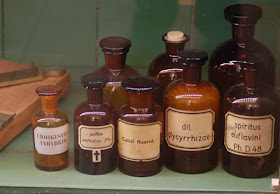 |
| Asian Flax/photo Høvblege, Møn:gb |
Linum usitatissimum
var. humile = linseed (oliehør)
var. vulgare = flax (textile flax)
 |
| Wild flax (wikipedia) |
History and Folkore about Flax/Linen in Denmark
(source: Brøndegaard, Folk og Flora, Dansk Etnobotanik)
 |
| linseeds (wikipedia) |
At the Danish island of Bornholm were in clay pots found prints of linseeds from Bronze Age. Finds of yarn and linen fabrics from the same period were probably imported wares. Linseed was probably cultivated at Bornholm in Bronze Age 800-400 BC as a nutrition. ( - eating the oilrich seeds evt. mixed with barley). From early Roman Iron Age are known several imprints of linseeds in claypots, mostly together with barley and burnt seeds.
 |
| Tollundman, Silkeborg Museum( photo SBN/GB) |
From the time before 1 BC are not known any finds of Danish cultivated flax. The textile flax must have arrived to Denmark from eastern Europe. Flax was in the 1200s used as a payment of medium of exchange. Already towards the end of the Middle Ages the cultivation had reached an extent. In 1312 taxes were paid from flax in Århus district. Not until ab. 1400 it seems that linen was of importance as a commercial product. The linen was in the Middle Ages used for towels, dishtowels, cloths, curtains, rugs (esp. a cover for horses), sacks and purses.
 |
| 14th century, depicting linen, wikipedia |
In 1506 the Jutland farmers objected to pay taxes of flax( flax was not corn) but the magistrate was against them. Provisions for the linseed production were found in many city laws. The linseed farm had to be securely fenced etc. Before and during the Absolutism the government tried with regulations to support and expand the breeding.
 |
| Flax, Open Air Museum in Brede, Zealand(wikipedia) |
The government urged from 1748 people
 |
| Linen laid out for bleaching in field,( J.Th. Lundbye). |
The farming of linseed had a big upturn during WWI an WWII.
Rules about sowing
 |
| The sower, van Gogh, Wikipedia |
The farmer had to sow linseed on the 100th day of the year = 10 april. Then the growth would succeed best and avoid frost damage - or he might sow on the 1. of May - or in the first half of May. The 16th of May was called "linseed day" or "Saras day". If the seeds were sown on a Saturday the wearer of the linen would get lice. The seeds had to be sown close to the farm so the seeds could hear the gate creak!
The sower had to creep while he was sowing the linseeds, women must not sow , they were only allowed to look - or the sower had to roll up his pants high, and he had to walk on his toes or swing his legs as high as he wished the linen to grow, and keep his head high and throw the rest of a handful of seeds over a horse's head.
Superstition
 |
| Medieval woodcut, wikipedia |
If a May branch was put in a flax field on Midsummer's day the trolls would stay away.
A flax field was a very pretty sight when it was blooming like a big light blue carpet and flax was almost considered a sacred plant because baby Jesus was swept in linen. Women had to curtsey respectfully when they passed the flax field
A swarm of bees must not be pursured in the flax field.
The evening before Walpurgis day linseed had to be strewn around the farm against witchcraft and trolls. To avoid sickness in cattle linseed and earth from the church yard had to be strewn in the stable and put in a cross over the back and head of the cow. Linseed upon the beams of the stable healed sick pigs.
The seeds were a part of the fodder for bewitched chickens .

People were protected against ghosts when they carried a bag with linseed, magistrantia and fly-rowan. This was effective against ghosts, spectres and other supernatural beings. Against nightmares people strew linseed upon the treshold and went backwards to bed
Linseeds in the coffin tied the dead to the grave, but if the seeds were put in the coffin before the body, they worked opposite.
Linseeds put in the pillow for newborn children made them bright and healthy.
 |
| Old Medicine, Viborg Museum, photo gb. |
The seeds crushed with salt heals snake bites. Crushed with incense in water and rubbed on watery eyes. Burnt seeds mixed with oil and butter on pillow against hair loss.
Henrik Smid 1546: Decoct of seeds with honey in water internally and the cooked seeds as a cover for intern diseases. Linseed oil rubbed on stomach against colics. Linseeds or the oil rubbed on burns.
Simon Paulli 1648: Crushed seeds cooked in milch or water upon swellings. Raw flax yarn cooked in lye as a cover, easing lower back pain caused by blatterstone.
The linseeds were written into the Pharmacopoeia in 1722
 |
| Medieval pharmacy, wikipedia |
Domestic animals.
Linseed and linseed oil were used for cattle, horse, dogs, sheep and chicken.
Source: Brøndegaard, Dansk Etnobotanik Folk og Flora
Photo: grethe bachmann
Photo Copy:wikipedia












